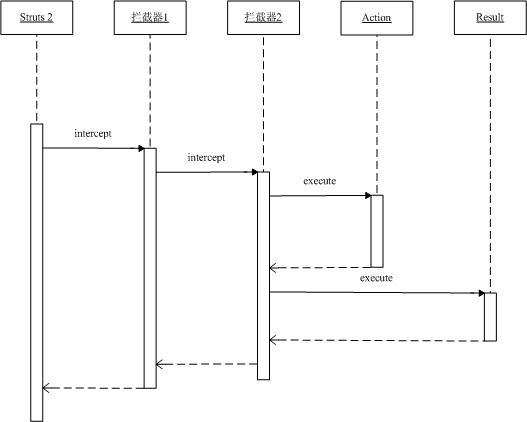Struts002——拦截器Interceptor的原理和自定义
Interceptor(以下译为拦截器)是Struts 2的一个强有力的工具,有许多功能(feature)都是构建于它之上,如国际化、转换器,校验等。
什么是拦截器
拦截器,在AOP(Aspect-Oriented Programming)中用于在某个方法或字段被访问之前,进行拦截然后在之前或之后加入某些操作。拦截是AOP的一种实现策略。
在Webwork的中文文档的解释为——拦截器是动态拦截Action调用的对象。它提供了一种机制可以使开发者可以定义在一个action执行的前后执行的代码,也可以在一个action执行前阻止其执行。同时也是提供了一种可以提取action中可重用的部分的方式。
谈到拦截器,还有一个词大家应该知道——拦截器链(Interceptor Chain,在Struts 2中称为拦截器栈Interceptor Stack)。拦截器链就是将拦截器按一定的顺序联结成一条链。在访问被拦截的方法或字段时,拦截器链中的拦截器就会按其之前定义的顺序被调用。
实现原理
Struts 2的拦截器实现相对简单。当请求到达Struts 2的ServletDispatcher时,Struts 2会查找配置文件,并根据其配置实例化相对的拦截器对象,然后串成一个列表(list),最后一个一个地调用列表中的拦截器,如下图所示。
已有的拦截器
Struts 2已经为您提供丰富多样的,功能齐全的拦截器实现。大家可以到struts2-core-2.1.8.1.jar包的struts-default.xml查看关于默认的拦截器与拦截器链的配置。
在struts-default.xml中已经配置了以上的拦截器。如果您想要使用上述拦截器,只需要在应用程序struts.xml文件中通过“<include file="struts-default.xml" />”将struts-default.xml文件包含进来,并继承其中的struts-default包(package),最后在定义Action时,使用“<interceptor-ref name="xx" />”引用拦截器或拦截器栈(interceptor stack)。一旦您继承了struts-default包(package),所有Action都会调用拦截器栈 ——defaultStack。当然,在Action配置中加入“<interceptor-ref name="xx" />”可以覆盖defaultStack。
?
下面是关于拦截器timer使用的例子。首先,新建Action类:TimerInterceptorAction.java,内容如下:
package com.zenoh.action;import com.opensymphony.xwork2.ActionSupport;public class TimerInterceptorAction extends ActionSupport { @Override public String execute() { try { // 模拟耗时的操作 Thread.sleep( 500 ); } catch (Exception e) { e.printStackTrace(); } return SUCCESS; } }MyInterceptor.java
package com.zenoh.interceptor;import com.opensymphony.xwork2.ActionInvocation;import com.opensymphony.xwork2.interceptor.AbstractInterceptor;@SuppressWarnings("serial")public class MyInterceptor extends AbstractInterceptor {@Overridepublic String intercept(ActionInvocation invocation) throws Exception {String result = null;// invocation.invoke()之前的代码,将会在Action之前被依次执行String actionName = invocation.getAction().getClass().getName();// 获取此次调用的Action的方法名String method = invocation.getProxy().getMethod();System.out.println("开始执行" + actionName + "的" + method + "方法");result = invocation.invoke(); // 调用下一个资源// invocation.invoke()之后的代码,将会在Action之后被逆序执行System.out.println("执行" + actionName + "的" + method + "方法完毕");return result;}}?
src/struts.xml
<?xml version="1.0" encoding="UTF-8" ?><!DOCTYPE struts PUBLIC "-//Apache Software Foundation//DTD Struts Configuration 2.0//EN" "http://struts.apache.org/dtds/struts-2.0.dtd"><struts><include file="struts-default.xml"></include> <constant name="struts.enable.DynamicMethodInvocation" value="false" /> <constant name="struts.devMode" value="true" /> <package name="InterceptorDemo" namespace="/" extends="struts-default"><interceptors> <!-- 自定义拦截器 --> <interceptor name="myInterceptor" /> <global-results> <result name="error">/error.jsp</result> </global-results> <global-exception-mappings> <exception-mapping exception="java.lang.Exception" result="error"/> </global-exception-mappings> <action name ="Timer" class ="com.zenoh.action.TimerInterceptorAction" > <!-- 这里配置拦截器 --> <interceptor-ref name="myInterceptor"/> <interceptor-ref name ="timer"/> <result>/Timer.jsp</result> </action > </package></struts>
?下面是输出信息:
开始执行com.zenoh.action.TimerInterceptorAction的execute方法2011-5-21 16:59:08 com.opensymphony.xwork2.util.logging.commons.CommonsLogger info信息: Executed action [//Timer!execute] took 516 ms.执行com.zenoh.action.TimerInterceptorAction的execute方法完毕
?Struts2拦截器的原理: 客户端请求某一个Action时,都会经过配置好的拦截器。
?
?配置Action,名为Timer,配置文件如下:
<! DOCTYPE struts PUBLIC "-//Apache Software Foundation//DTD Struts Configuration 2.0//EN" "http://struts.apache.org/dtds/struts-2.0.dtd" > < struts > < include file ="struts-default.xml" /> < package name ="InterceptorDemo" extends ="struts-default" > < action name ="Timer" class ="com.zenoh.action.TimerInterceptorAction" > < interceptor-ref name ="timer" /> < result > /Timer.jsp </ result > </ action > </ package > </ struts >
?
至于Timer.jsp可以随意写些什么到里面。发布运行应用程序,在浏览器的地址栏键入http://localhost:8080/Struts2_Interceptor/Timer.action,在出现Timer.jsp页面后,查看服务器的后台输出。
信息: Executed action [ //Timer!execute ] took 2859 ms.
?
在您的环境中执行Timer!execute的耗时,可能上述的时间有些不同,这取决于您PC的性能。但是无论如何,2859 ms与500 ms还是相差太远了。这是什么原因呢?其实原因是第一次加载Timer时,需要进行一定的初始工作。当你重新请求Timer.action时,以上输出会变为:
信息: Executed action [ //Timer!execute ] took 500 ms.
?OK,这正是我们期待的结果。上述例子演示了拦截器timer的用途——用于显示执行某个action方法的耗时,在我们做一个粗略的性能调试时,这相当有用。
?
自定义拦截器
所有的Struts 2的拦截器都直接或间接实现接口